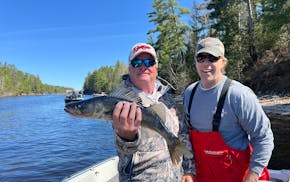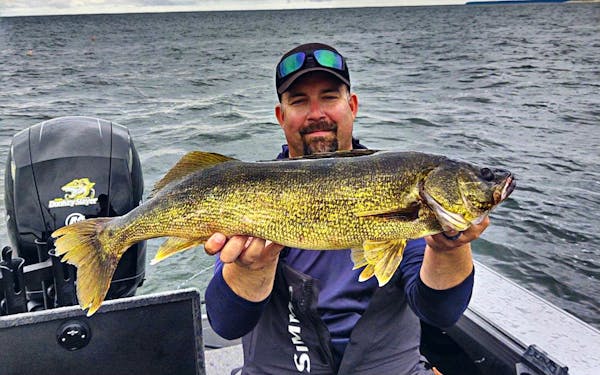Forward-facing sonar — which only a few years ago seemed too futuristic to impact Minnesota fish and fishing, and anyway seemed too costly for most anglers to acquire for use in their boats and, in winter, on frozen lakes — now is nearly everywhere and is likely to be used by tens of thousands to target walleyes when open water season begins in a few weeks.
If you doubt that, check out specific angling groups on Facebook. One for Garmin LiveScope forward-facing imaging users has about 135,000 members. Another for competing Lowrance ActiveTarget units has 30,000.
Put another way, the future is here, and there's no going back.
Developed first by Garmin, forward-facing sonar allows anglers to fish only where fish are and to direct baits specifically to the located fish.
Example:
Pick a day in July or August, when walleyes tend to suspend in a water column, either to seek comfortable temperatures or to find baitfish. Located by anglers in a boat using forward-facing sonar, the fish can be targeted by the anglers as they hang back in their boat 30 or 40 feet from the fish, casting leech- or nightcrawler-baited jigs rigged with slip bobbers.
If the anglers' casts fly errantly, they can re-cast, because the baits' locations relative to the location of the fish often appear on the sonar's display.
Employing forward-facing sonar, Twin Cities angler Cory Villaume, 40, has made countless similar casts to walleyes. Like other Minnesota anglers in recent years, he's ponied up the $2,500-$3,500 that forward-facing sonar units cost.
Villaume's goal isn't to keep more fish; he releases almost all the fish he catches. Instead, he uses forward-facing sonar to increase his fishing enjoyment while expanding his knowledge of fish and fish behavior. To keep up with fishing technology developments, he stays attuned to social media and particularly to YouTube, where how-to videos by knowledgeable forward-facing imaging users are ubiquitous.
Here, Villaume answers key questions about forward-facing sonar.
Q: How difficult, or easy, is it to learn to use these units?
A: It takes a little while to figure out. But generally, it's easy.
Q: What's your sense of how popular they are among Minnesota anglers?
A: I know more people who have them than don't.
Q: Can their widespread use by anglers negatively affect fisheries?
A: It's possible. Panfish are particularly vulnerable, I think, perhaps crappies most of all. Especially in winter and later in summer when they suspend, you can find them with this new sonar, whereas before, without it, locating them was hard. That said, sonar doesn't kill fish; people do. Knowing how to catch and release fish safely is important, and everyone should practice it. Also, in my view, all fish limits should be lower.
Q: How is sonar used to fish walleyes?
A: Lots of ways. Most importantly, it allows you to find walleyes, then stay away from them so you don't spook them and cast to them from a distance. It also has enhanced the use of artificial baits, which are more useful and effective now for this type of fishing. Plastics, for instance, I use quite a bit, and Berkley is even making an artificial bait designed for use with forward-facing sonar.
Q: What has using the new sonar taught you about fish that you didn't know?
A: That's the best part: You learn a lot about fish locations and fish behavior — things that before you had to guess at. Boats spook fish, for example. Maybe it's the sound of a motor. Or, on clear days, the shadow a boat throws. A lot of sonar users believe the units themselves emit a sound wave that can spook fish.
Q: Can these units help you distinguish fish species? Or the relative sizes of fish?
A: Perhaps with big fish, like muskies, you could tell comparable sizes. And by location, you can generally guess whether fish you're seeing are walleyes or, for example, crappies.
Q: How did you become aware of forward-facing sonar?
A: About four years ago a buddy asked me to run out to Lac qui Parle to fish crappies, and he had a Garmin LiveScope we used to locate them in midday. We couldn't drill holes on top of them, because they spooked. So we flanked them with other holes. Again, we released almost all we caught, and this was in shallow water, so they did well. But if you weren't conservation-minded, you could hurt these fish. Anyway, on my way home I said, 'I've got to get one of those.' Now I have two in my boat.
Q: What's the chance fish will bite once you find them with the new sonar?
A: If they want to bite, they'll move a few feet to get a bait. You can watch them do that. But if they don't want to bite, you can't make them. That's the educational part. On Rainy Lake one evening last summer, we marked 100 walleyes but got only four to bite. Also on Green Bay two weeks ago, we saw a lot of fish but got only nine in two days. As always in fishing, it matters a lot how clear the water is, whether it's sunny or cloudy, and whether the wind is flat or breezy. Sometimes, for whatever reason, they just won't bite.

Anderson: In early June, Minnesota fish are begging to be caught. Won't you help?

Anderson: Tails wagging, DNR officers' dogs find lost people and missing evidence
Anderson: Punish poachers more
Anderson: The Chainsaw Sisters Saloon is gone, but the Echo Trail is still a pathway to possibilities


